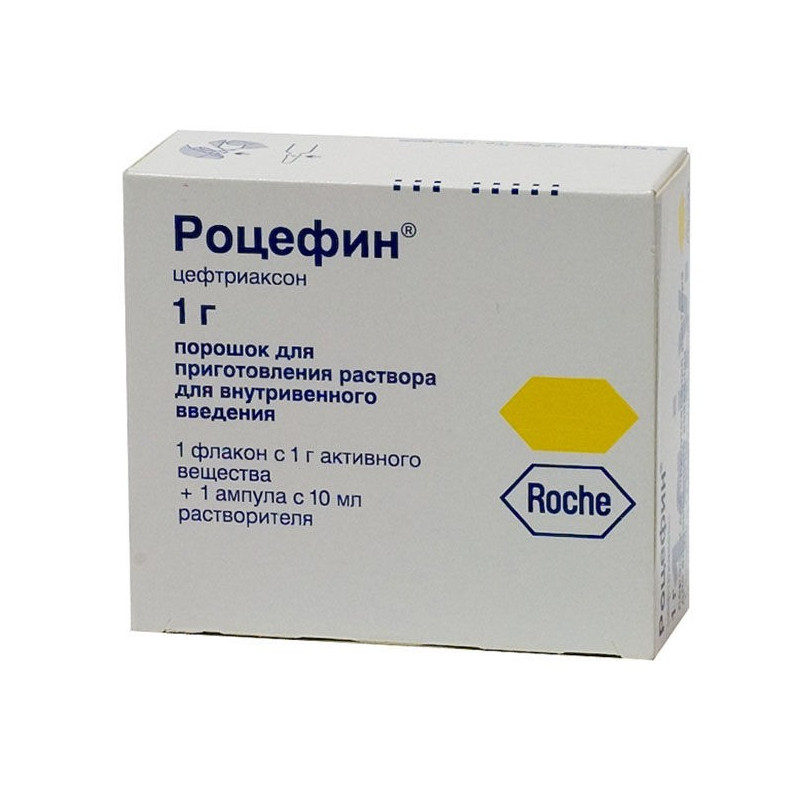



 All payments are encrypted via SSL
All payments are encrypted via SSL
 Full Refund if you haven't received your order
Full Refund if you haven't received your order
Powder for solution for injection
1 bottle complete with solvent.
Rocefin is a long-acting III generation broad-spectrum cephalosporin antibiotic for parenteral administration. The bactericidal activity of the drug is due to the suppression of the synthesis of cell membranes. Rocefin is highly resistant to most beta-lactamase gram-negative and gram-positive microorganisms.
Active against gram-positive aerobes: Staphylococcus aureus, Staphylococcus epidermidis, Streptococcus pneumoniae, Streptococcus pyogenes, Streptococcus agalactiae, Streptococcus viridans, Streptococcus bovis;Gram-negative aerobes: Aeromonas spp., Alcaligenes spp., Branhamella catarrhalis (forming and non-forming beta-lactamase), Citrobacter spp., Enterobacter spp. (some strains are resistant), Escherichia coli, Haemophilus ducreyi, Haemophilus influenzae (including strains forming penicillinase), Haemophilus parainfluenzae, Klebsiella spp. (including Klebsiella pneumoniae), Moraxella spp., Morganella morganii, Neisseria gonorrhoeae (including strains that form penicillinase), Neisseria meningitidis, Plesiomonas shigelloides, Proteus mirabilis, Proteus mirabilis, Proteus mirabilis, Proteus mirabilis, Proteus mirabilis, Proteus mirabilis, Proteus mirabilis, Proteus mirabilis, Proteus mirabilis, Proteus mirabilis, Proteus mirabilis, Proteus mirabilis, Proteus mirabilis, Proteus mirabilis, Proteus mirabilis, Proteus mirabilis, Proteus mirabilis, Proteus mirabilis, Proteus mirabilus (including Salmonella typhi), Serratia spp. (including Serratia marcescens), Shigella spp., Vibrio spp. (including Vibrio cholerae), Yersinia spp. (including Yersinia enterocolitica), individual strains of Pseudomonas aeruginosa are also susceptible to the drug; anaerobes: Bacteroides spp. (including some strains of Bacteroides fragilis), Clostridium spp. (except Cl.difficile), Fusobacterium spp. (except Fusobacterium mortiferum and Fusobacterium varium), Peptococcus spp., Peptostreptococcus spp.
To the action of the drugare resistant strains of Staphylococcus spp., showing resistance to methicillin, strains of Enterococcus, many strains of Bacteroides spp., producing beta-lactamase.
Treatment of infectious diseases caused by microorganisms sensitive to the drug:
- sepsis;
- meningitis;
- infectious diseases of the abdominal cavity organs (peritonitis, infections of the gall tract and the gastrointestinal tract);
- infectious diseases of bones, joints, soft tissues, skin, and also wound infections;
- infectious diseases in persons with weakened immunity;
- infectious diseases of the upper and lower respiratory tract (including pneumonia);
- infectious diseases of the kidneys and urinary tract;
- Infectious diseases of the genital organs (including gonorrhea).
Prevention of postoperative infectious complications.
Hypersensitivity to cephalosporins and penicillins.
The safety of the drug during pregnancy has not been established.
If necessary, the appointment of the drug during lactation should decide on the termination of breastfeeding. In low concentrations, Ceftriaxone is excreted in breast milk.
In experimental studies no embryotoxic, fetotoxic, teratogenic effects or other adverse factors were identified on the fecundity of males and females, the process of childbirth, perinatal and postnatal development of offspring. No signs of embryotoxicity or teratogenicity were observed in primates.
Adults and children over 12 years old appoint 1-2 g of Rocefina 1 time / day. Depending on the clinical situation, the daily dose can be increased to 4 g.
Newborn (up to 2 weeks) prescribed in a dose of 20-50 mg / kg of body weight 1 time / day.
When calculating the dose, the degree of the child's term is not taken into account.
Infants (from 3 weeks of age) and children under the age of 12 years appoint 20-80 mg / kg body weight 1 time / day.
Children weighing over 50 kg prescribe a dose for adults.
The duration of treatment is set individually. As a rule, the introduction of the drug should be continued for another 48-72 hours after the temperature normalizes.
With bacterial meningitis in infants and young children Treatment begins with a dose of 100 mg / kg body weight (but not more than 4 g) 1 time / day. When identifying the pathogen and the degree of its sensitivity to the drug dose can be adjusted. The duration of treatment depends on the pathogen and can be from 4 days forNeisseria meningitidisup to 7 days for sensitive strains St. pneumoniae.
With gonorrhea It is recommended to inject 250 mg intramuscularly once.
For the prevention of postoperative complications It is recommended to administer once to 1-2 grams of Rocefin (depending on the degree of danger of infection) 30-90 minutes before the operation. In operations on the colon and rectum, additional administration of a drug from the group of 5-nitroimidazoles is recommended.
Gastrointestinal: diarrhea, nausea, vomiting, stomatitis, glossitis; rarely, an increase in transaminase activity, a darkening on the echogram of the gallbladder.
Hemic and lymphatic: eosinophilia, leukopenia, granulocytopenia, hemolytic anemia, thrombocytopenia.
From the side of the central nervous system: headache, dizziness.
Allergic reactions: rash, itching, dermatitis, urticaria, edema, exudative polyformal erythema; rarely, anaphylactoid or Anaphylactic reactions.
Local reactions: in rare cases - phlebitis. V / m administration without Lidocaine is painful.
Effects due to biological effects: possible development of superinfection (mycosis of the genital tract).
Other: oliguria, increased serum creatinine, fever, chills, bleeding disorders.
The frequency of all side effects does not exceed 2%.
With simultaneous severe renal and hepatic insufficiency, it is necessary to regularly determine the concentration of the drug in the blood plasma.
In patients on hemodialysis, it is necessary to monitor the drug concentration in the blood plasma, because they may decrease its rate of excretion.
With long-term drug treatment is necessary to regularly monitor the picture of peripheral blood.
In rare cases with ultrasound of the gallbladder, there are blackouts that disappear after discontinuation of the drug. Even if this phenomenon is accompanied by pain in the right hypochondrium, only symptomatic treatment is recommended.
After drinking alcohol after taking Rocefin, no effects similar to the effects of disulfiram (teturam) were observed.
Use in pediatrics
Newborn babies with hyperbilirubinemia, especially premature, Rocephine should be administered with caution.
Rocefin and aminoglycosides have synergistic effects against many gram-negative bacteria.
With the simultaneous use of high doses of Rocefin and "loop" diuretics, for example, Furosemide, renal impairment was not observed. There is no indication that Rocefin increases aminoglycoside nephrotoxicity.
Probenecid has no effect on Rocefin elimination.
Rocefina solution is incompatible with solutions containing other antibiotics (both during preparation and when administered)
Keep out of reach of children at temperature up to 30 С
